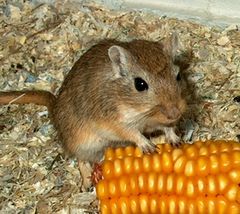- Meriones (genus)
-
For other uses, see Meriones (disambiguation).
Meriones
Temporal range: Early Pleistocene - Recent
Meriones unguiculatus Scientific classification Kingdom: Animalia Phylum: Chordata Class: Mammalia Order: Rodentia Family: Muridae Subfamily: Gerbillinae Tribe: Gerbillini Subtribe: Rhombomyina Genus: Meriones
Illiger, 1811Subgenera Meriones
Parameriones
Pallasiomys
ChelionesMeriones is a rodent genus that includes the gerbil most commonly kept as a pet, Meriones unguiculatus. The genus contains most animals referred to as jirds, but members of the genera Sekeetamys, Brachiones, and sometimes Pachyuromys are also known as jirds. The distribution of Meriones ranges from northern Africa to Mongolia. Meriones jirds tend to inhabit arid regions including clay desert, sandy desert, and steppe, but are also in slightly wetter regions and are an agricultural pest.
Contents
Description
Adult Meriones range in size from 9 to 18 cm (head and body) with a tail that is equal to or slightly longer than the rest of the animal (Corbet and Hill, 1992; Nowak, 1999). Weight varies widely by species but is generally between 30-100 grams.
They are more rat-like in appearance than many other gerbillines, but are still capable of leaping. They have strong front claws which are used to dig their burrows.
Natural history
They construct burrows that aid in food storage, temperature regulation and water retention. The burrows of some species are rather simple, but others can be quite complex. Meriones crassus adults have been reported to have burrows that have a combined length of over 30 meters and have 18 entrances (Nowak, 1999). Food is stored in chambers of the burrows. As with other arid adapted rodents, stored food has the capacity to reabsorb moisture given off by the animal during respiration. Jirds can go their entire lives without drinking, relying instead on water generated during metabolism. These rodents feed on vegetable matter, roots, seeds, fruit, and insects.
Members of the genus range from being social to rather solitary. Even in solitary species, home ranges often overlap. Females give birth to 1-12 young after a gestation period of about 20-30 days (Nowak, 1999). Sexual maturity is reached after about 9-15 weeks. Longevity in the wild is usually less than 6 months, but the record for a captive animal is over 5 years (Nowak, 1999).
Classification
Pavlinov et al. (1990) considered the genus to belong to the (sub)tribe Rhombomyina, a group of mostly Asian gerbils. Tong's (1989) hypothesized relationship is consistent and Pavlinov et al.'s (1990) taxonomy was adopted by Musser and Carleton (2005). McKenna and Bell (1997) use the subtribe name Merionina (presumably arguing that it has priority) for the same group.
In particular, Meriones is thought by Pavlinov et al. (1990) to be sister (cladistically closest) to the genus Brachiones. Tong (1989), however, suggests that Psammomys is its sister genus.
There are 17 species of Meriones jirds divided into 4 subgenera.
Genus Meriones
- Subgenus Meriones
- Tamarisk Jird, Meriones tamariscinus
- Subgenus Parameriones
- Persian Jird, Meriones persicus
- King Jird, Meriones rex
- Subgenus Pallasiomys
- Arabian Jird, Meriones arimalius
- Cheng's Jird, Meriones chengi
- Sundevall's Jird, Meriones crassus
- Dahl's Jird, Meriones dahli
- Moroccan Jird, Meriones grandis
- Libyan Jird, Meriones libycus
- Midday Jird, Meriones meridianus
- Buxton's Jird, Meriones sacramenti
- Shaw's Jird, Meriones shawi
- Tristram's Jird, Meriones tristrami
- Mongolian Jird (Mongolian Gerbil), Meriones unguiculatus
- Vinogradov's Jird, Meriones vinogradovi
- Zarudny's Jird, Meriones zarudnyi
- Subgenus Cheliones
- Indian Desert Jird, Meriones hurrianae
References
- Corbet, Gordon Barclay; John Edwards Hill (1992). The mammals of the Indomalayan region: a systematic review. New York: Oxford University Press. ISBN 0-19-854693-9.
- McKenna, Malcolm C.; Susan K.Bell (1997). Classification of Mammals above the Species Level. New York: Columbia University Press. ISBN 0-231-11012-X.
- Musser, Guy G.; Michael D. Carleton (2005). "Superfamily Muroidea". In Don E. Wilson and DeeAnn M. Reeder (eds.). Mammal species of the world : a taxonomic and geographic reference (3rd ed.). Baltimore: Johns Hopkins University Press. pp. 894–1531. ISBN 0-8018-8221-4.
- Nowak, Ronald M. (1999). Walker's Mammals of the World, volume 2. London: Johns Hopkins University Press. ISBN 0-8018-5789-9.
- Pavlinov, I. Ya., Yu. A. Dubrovskiy, O. L. Rossolimo, E. G. Potapova. 1990. Gerbils of the world. Moscow: Nauka.
- Tong, Haiyan (1989). "Origine et évolution des Gerbillidae (Mammalia, Rodentia) en Afrique du Nord". Mémoires de la Société géologique de France, nouvelle série 155: 1–120. ISBN 2-85363-050-1,.
Categories:- Gerbils
- Subgenus Meriones
Wikimedia Foundation. 2010.
